Paper Menu >>
Journal Menu >>
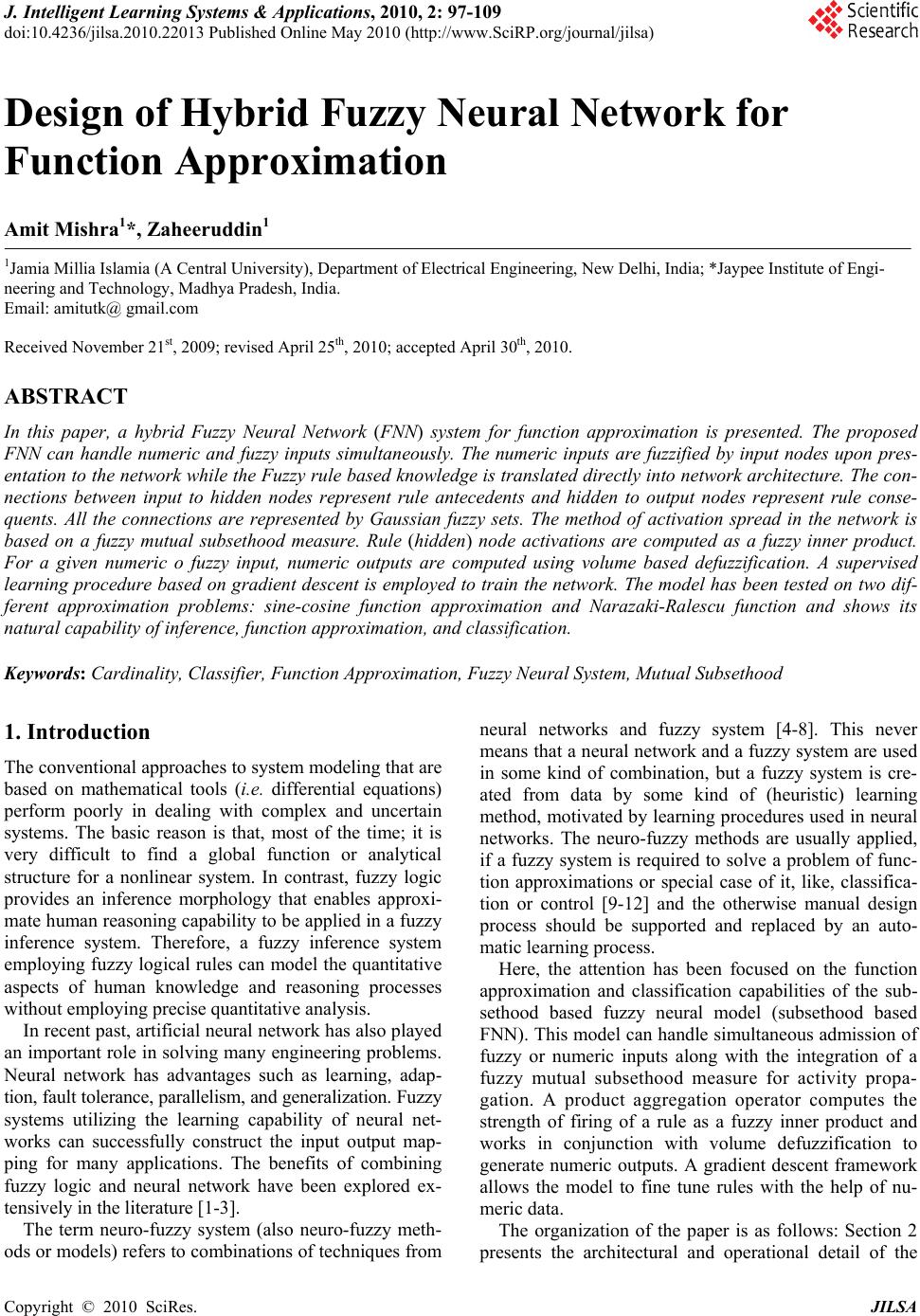 J. Intelligent Learning Systems & Applications, 2010, 2: 97-109 doi:10.4236/jilsa.2010.22013 Published Online May 2010 (http://www.SciRP.org/journal/jilsa) Copyright © 2010 SciRes. JILSA 97 Design of Hybrid Fuzzy Neural Network for Function Approximation Amit Mishra1*, Zaheeruddin1 1Jamia Millia Islamia (A Central University), Department of Electrical Engineering, New Delhi, India; *Jaypee Institute of Engi- neering and Technology, Madhya Pradesh, India. Email: amitutk@ gmail.com Received November 21st, 2009; revised April 25th, 2010; accepted April 30th, 2010. ABSTRACT In this paper, a hybrid Fuzzy Neural Network (FNN) system for function approximation is presented. The proposed FNN can handle numeric and fuzzy inputs simultaneously. The numeric inputs are fuzzified by input nodes upon pres- entation to the network while the Fuzzy rule based knowledge is translated directly into network architecture. The con- nections between input to hidden nodes represent rule antecedents and hidden to output nodes represent rule conse- quents. All the connections are represented by Gaussian fuzzy sets. The method of activation spread in the network is based on a fuzzy mutual subsethood measure. Rule (hidden) node activations are computed as a fuzzy inner product. For a given numeric o fuzzy input, numeric outputs are computed using volume based defuzzification. A supervised learning procedure based on gradient descent is employed to train the network. The model has been tested on two dif- ferent approximation problems: sine-cosine function approximation and Narazaki-Ralescu function and shows its natural capability of inference, function approximation, and classification. Keywords: Cardinality, Classifier, Function Approximation, Fuzzy Neural System, Mutual Subsethood 1. Introduction The conventional approaches to system modeling that are based on mathematical tools (i.e. differential equations) perform poorly in dealing with complex and uncertain systems. The basic reason is that, most of the time; it is very difficult to find a global function or analytical structure for a nonlinear system. In contrast, fuzzy logic provides an inference morphology that enables approxi- mate human reasoning capability to be applied in a fuzzy inference system. Therefore, a fuzzy inference system employing fuzzy logical rules can model the quantitative aspects of human knowledge and reasoning processes without employing precise quantitative analysis. In recent past, artificial neural network has also played an important role in solving many engineering problems. Neural network has advantages such as learning, adap- tion, fault tolerance, parallelism, and generalization. Fuzzy systems utilizing the learning capability of neural net- works can successfully construct the input output map- ping for many applications. The benefits of combining fuzzy logic and neural network have been explored ex- tensively in the literature [1-3]. The term neuro-fuzzy system (also neuro-fuzzy meth- ods or models) refers to combinations of techniques from neural networks and fuzzy system [4-8]. This never means that a neural network and a fuzzy system are used in some kind of combination, but a fuzzy system is cre- ated from data by some kind of (heuristic) learning method, motivated by learning procedures used in neural networks. The neuro-fuzzy methods are usually applied, if a fuzzy system is required to solve a problem of func- tion approximations or special case of it, like, classifica- tion or control [9-12] and the otherwise manual design process should be supported and replaced by an auto- matic learning process. Here, the attention has been focused on the function approximation and classification capabilities of the sub- sethood based fuzzy neural model (subsethood based FNN). This model can handle simultaneous admission of fuzzy or numeric inputs along with the integration of a fuzzy mutual subsethood measure for activity propa- gation. A product aggregation operator computes the strength of firing of a rule as a fuzzy inner product and works in conjunction with volume defuzzification to generate numeric outputs. A gradient descent framework allows the model to fine tune rules with the help of nu- meric data. The organization of the paper is as follows: Section 2 presents the architectural and operational detail of the 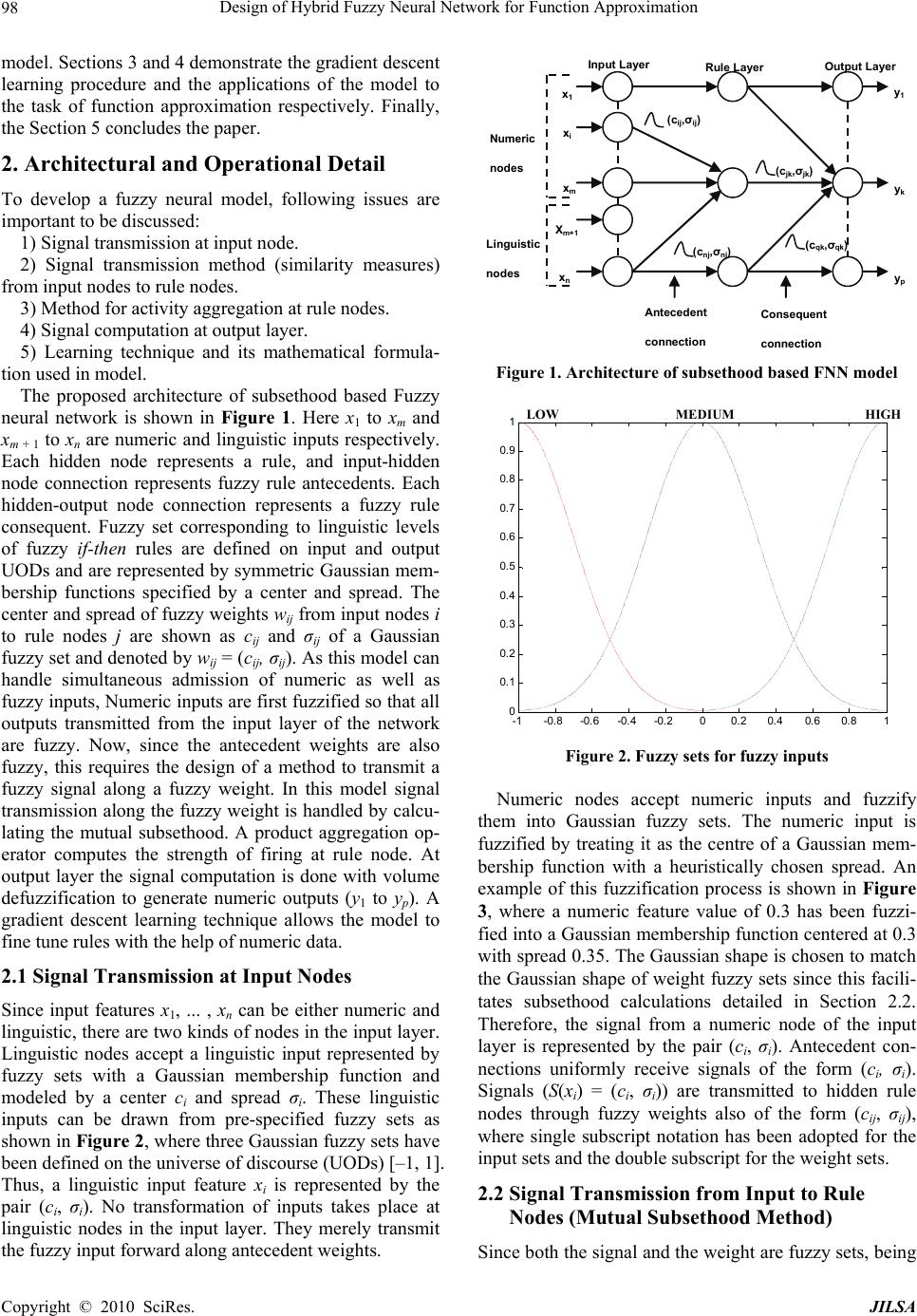 Design of Hybrid Fuzzy Neural Network for Function Approximation 98 model. Sections 3 and 4 demonstrate the gradient descent learning procedure and the applications of the model to the task of function approximation respectively. Finally, the Section 5 concludes the paper. 2. Architectural and Operational Detail To develop a fuzzy neural model, following issues are important to be discussed: 1) Signal transmission at input node. 2) Signal transmission method (similarity measures) from input nodes to rule nodes. 3) Method for activity aggregation at rule nodes. 4) Signal computation at output layer. 5) Learning technique and its mathematical formula- tion used in model. The proposed architecture of subsethood based Fuzzy neural network is shown in Figure 1. Here x1 to xm and xm + 1 to xn are numeric and linguistic inputs respectively. Each hidden node represents a rule, and input-hidden node connection represents fuzzy rule antecedents. Each hidden-output node connection represents a fuzzy rule consequent. Fuzzy set corresponding to linguistic levels of fuzzy if-then rules are defined on input and output UODs and are represented by symmetric Gaussian mem- bership functions specified by a center and spread. The center and spread of fuzzy weights wij from input nodes i to rule nodes j are shown as cij and σij of a Gaussian fuzzy set and denoted by wij = (cij, σij). As this model can handle simultaneous admission of numeric as well as fuzzy inputs, Numeric inputs are first fuzzified so that all outputs transmitted from the input layer of the network are fuzzy. Now, since the antecedent weights are also fuzzy, this requires the design of a method to transmit a fuzzy signal along a fuzzy weight. In this model signal transmission along the fuzzy weight is handled by calcu- lating the mutual subsethood. A product aggregation op- erator computes the strength of firing at rule node. At output layer the signal computation is done with volume defuzzification to generate numeric outputs (y1 to yp). A gradient descent learning technique allows the model to fine tune rules with the help of numeric data. 2.1 Signal Transmission at Input Nodes Since input features x1, ... , xn can be either numeric and linguistic, there are two kinds of nodes in the input layer. Linguistic nodes accept a linguistic input represented by fuzzy sets with a Gaussian membership function and modeled by a center ci and spread σi. These linguistic inputs can be drawn from pre-specified fuzzy sets as shown in Figure 2, where three Gaussian fuzzy sets have been defined on the universe of discourse (UODs) [–1, 1]. Thus, a linguistic input feature xi is represented by the pair (ci, σi). No transformation of inputs takes place at linguistic nodes in the input layer. They merely transmit the fuzzy input forward along antecedent weights. x 1 x i x m X m+1 x n Input Layer Rule Layer Output Layer Numeric nodes Linguistic nodes y 1 y k y p (c ij ,σ ij ) (c nj ,σ nj ) (c jk ,σ jk ) (c qk ,σ qk ) Antecedent connection Consequent connection Figure 1. Architecture of subsethood based FNN model LOWMEDIUM HIGH -1 -0.8 -0.6-0.4 -0.200.2 0.40.6 0.8 1 0 0.1 0.2 0.3 0.4 0.5 0.6 0.7 0.8 0.9 1 Figure 2. Fuzzy sets for fuzzy inputs Numeric nodes accept numeric inputs and fuzzify them into Gaussian fuzzy sets. The numeric input is fuzzified by treating it as the centre of a Gaussian mem- bership function with a heuristically chosen spread. An example of this fuzzification process is shown in Figure 3, where a numeric feature value of 0.3 has been fuzzi- fied into a Gaussian membership function centered at 0.3 with spread 0.35. The Gaussian shape is chosen to match the Gaussian shape of weight fuzzy sets since this facili- tates subsethood calculations detailed in Section 2.2. Therefore, the signal from a numeric node of the input layer is represented by the pair (ci, σi). Antecedent con- nections uniformly receive signals of the form (ci, σi). Signals (S(xi) = (ci, σi)) are transmitted to hidden rule nodes through fuzzy weights also of the form (cij, σij), where single subscript notation has been adopted for the input sets and the double subscript for the weight sets. 2.2 Signal Transmission from Input to Rule Nodes (Mutual Subsethood Method) Since both the signal and the weight are fuzzy sets, being Copyright © 2010 SciRes. JILSA 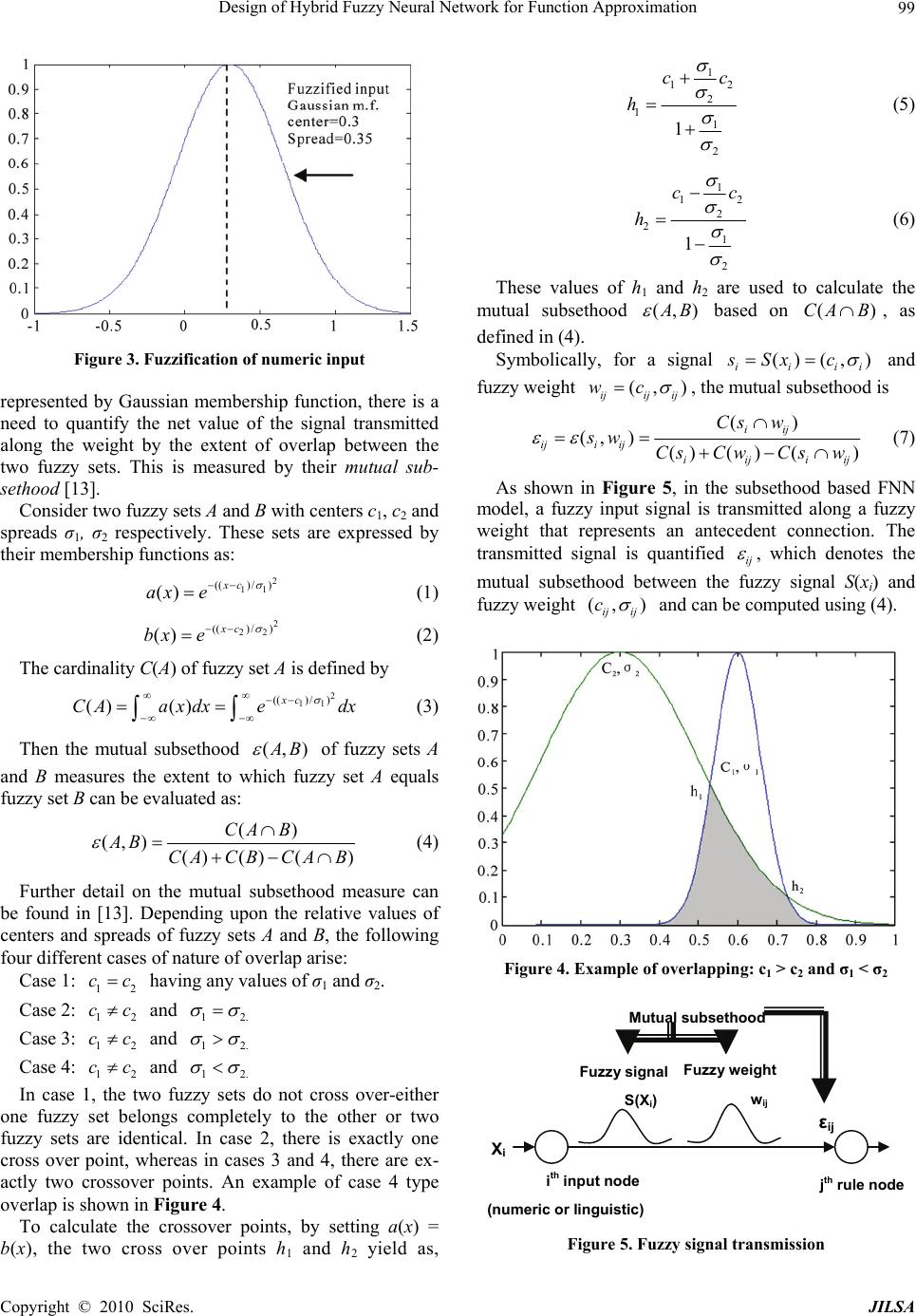 Design of Hybrid Fuzzy Neural Network for Function Approximation99 Figure 3. Fuzzification of numeric input represented by Gaussian membership function, there is a need to quantify the net value of the signal transmitted along the weight by the extent of overlap between the two fuzzy sets. This is measured by their mutual sub- sethood [13]. Consider two fuzzy sets A and B with centers c1, c2 and spreads σ1, σ2 respectively. These sets are expressed by their membership functions as: 2 11 (()/ ) () xc ax e (1) 2 22 (()/ ) () xc bxe (2) The cardinality C(A) of fuzzy set A is defined by 2 11 (()/ ) () ()xc CAaxdx edx (3) Then the mutual subsethood (,) A B of fuzzy sets A and B measures the extent to which fuzzy set A equals fuzzy set B can be evaluated as: () (,) () () () CA B AB CACBCA B (4) Further detail on the mutual subsethood measure can be found in [13]. Depending upon the relative values of centers and spreads of fuzzy sets A and B, the following four different cases of nature of overlap arise: Case 1: having any values of σ1 and σ2. 1 cc2 2. Case 2: and 1 cc12 Case 3: and 1 cc2.12 Case 4: and 1 cc2.12 In case 1, the two fuzzy sets do not cross over-either one fuzzy set belongs completely to the other or two fuzzy sets are identical. In case 2, there is exactly one cross over point, whereas in cases 3 and 4, there are ex- actly two crossover points. An example of case 4 type overlap is shown in Figure 4. To calculate the crossover points, by setting a(x) = b(x), the two cross over points h1 and h2 yield as, 1 12 2 1 1 2 1 cc h (5) 1 12 2 2 1 2 1 cc h (6) These values of h1 and h2 are used to calculate the mutual subsethood (,) A B based on (CA B) , as defined in (4). Symbolically, for a signal () (, ) iii sSx ci and fuzzy weight (, ) ijij ij wc , the mutual subsethood is () (, )()( )() iij ijiij iiji Cs w sw CsCwCsw ij (7) As shown in Figure 5, in the subsethood based FNN model, a fuzzy input signal is transmitted along a fuzzy weight that represents an antecedent connection. The transmitted signal is quantified ij , which denotes the mutual subsethood between the fuzzy signal S(xi) and fuzzy weight (, ) ij ij c and can be computed using (4). Figure 4. Example of overlapping: c1 > c2 and σ1 < σ2 i th input node (numeric or linguistic) j th rule node ε ij Fuzzy signal S(X i ) Fuzzy weight w ij Mutual subsethood X i Figure 5. Fuzzy signal transmission Copyright © 2010 SciRes. JILSA 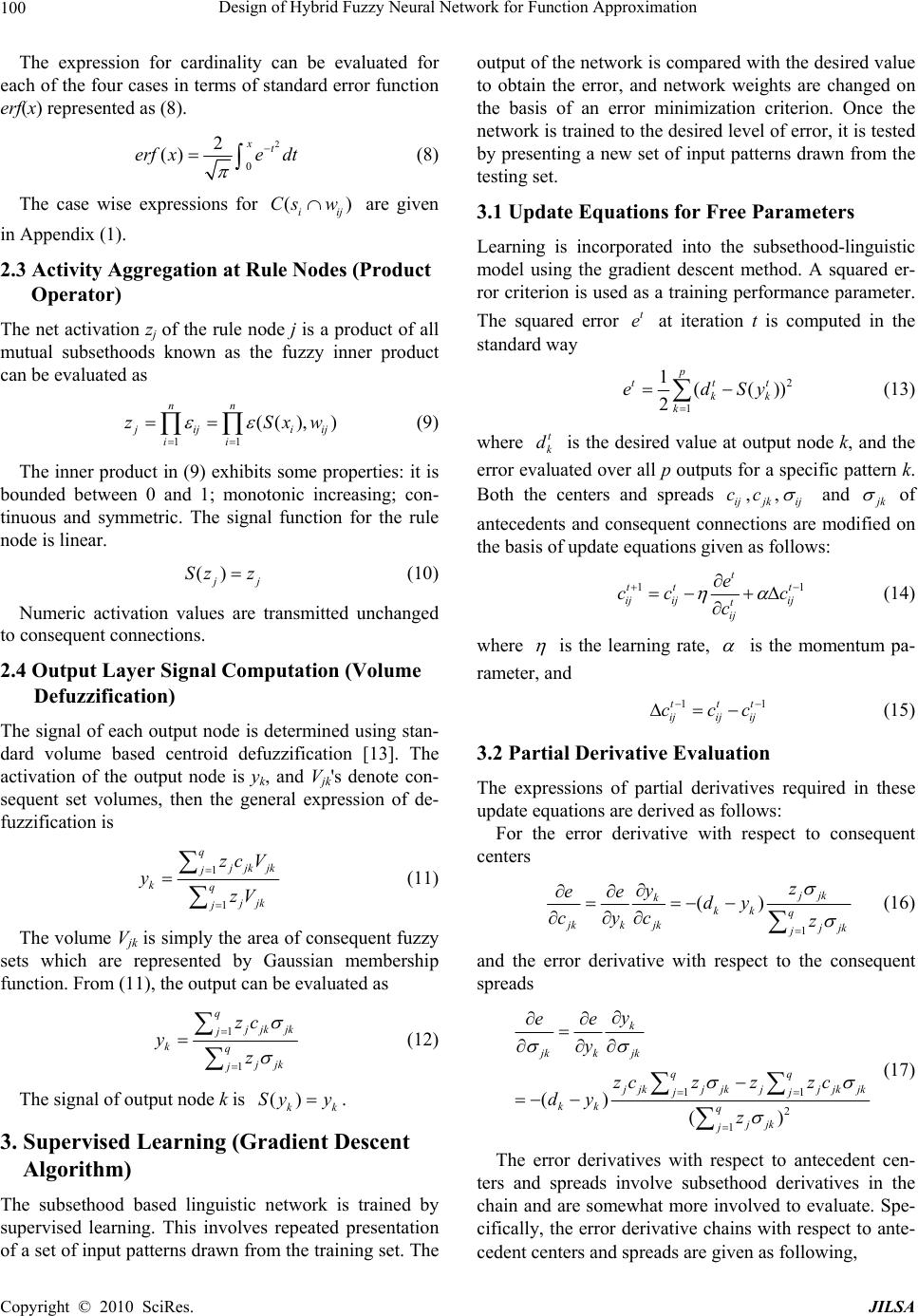 Design of Hybrid Fuzzy Neural Network for Function Approximation 100 The expression for cardinality can be evaluated for each of the four cases in terms of standard error function erf(x) represented as (8). 2 0 2 () xt erf xedt (8) The case wise expressions for are given in Appendix (1). ( iij Cs w) 2.3 Activity Aggregation at Rule Nodes (Product Operator) The net activation zj of the rule node j is a product of all mutual subsethoods known as the fuzzy inner product can be evaluated as 11 (( ),) nn j iji ij ii zS xw (9) The inner product in (9) exhibits some properties: it is bounded between 0 and 1; monotonic increasing; con- tinuous and symmetric. The signal function for the rule node is linear. () j j Sz z (10) Numeric activation values are transmitted unchanged to consequent connections. 2.4 Output Layer Signal Computation (Volume Defuzzification) The signal of each output node is determined using stan- dard volume based centroid defuzzification [13]. The activation of the output node is yk, and Vjk's denote con- sequent set volumes, then the general expression of de- fuzzification is 1 1 q j jk jk j kq jjk j zc V y zV (11) The volume Vjk is simply the area of consequent fuzzy sets which are represented by Gaussian membership function. From (11), the output can be evaluated as 1 1 q j jk jk j kq jjk j zc y z (12) The signal of output node k is . () kk Sy y 3. Supervised Learning (Gradient Descent Algorithm) The subsethood based linguistic network is trained by supervised learning. This involves repeated presentation of a set of input patterns drawn from the training set. The output of the network is compared with the desired value to obtain the error, and network weights are changed on the basis of an error minimization criterion. Once the network is trained to the desired level of error, it is tested by presenting a new set of input patterns drawn from the testing set. 3.1 Update Equations for Free Parameters Learning is incorporated into the subsethood-linguistic model using the gradient descent method. A squared er- ror criterion is used as a training performance parameter. The squared error at iteration t is computed in the standard way t e 2 1 1(() 2 p tt kk k edSy ) t (13) where is the desired value at output node k, and the error evaluated over all p outputs for a specific pattern k. Both the centers and spreads t k d ,, ij jkij cc and j k of antecedents and consequent connections are modified on the basis of update equations given as follows: 11 t tt t ij ijij t ij e cc c c (14) where is the learning rate, is the momentum pa- rameter, and 1ttt ijij ij ccc 1 (15) 3.2 Partial Derivative Evaluation The expressions of partial derivatives required in these update equations are derived as follows: For the error derivative with respect to consequent centers 1 () jjk k kk q jkk jk j jk j z y ee dy cyc z (16) and the error derivative with respect to the consequent spreads 11 2 1 () () k jkk jk qq j jkjjkjj jkjk jj kk q jjk j y ee y zczz zc dy z (17) The error derivatives with respect to antecedent cen- ters and spreads involve subsethood derivatives in the chain and are somewhat more involved to evaluate. Spe- cifically, the error derivative chains with respect to ante- cedent centers and spreads are given as following, Copyright © 2010 SciRes. JILSA  Design of Hybrid Fuzzy Neural Network for Function Approximation Copyright © 2010 SciRes. JILSA 101 1 1 () pjij k k ijkjij ij p j ij k kk k j ij ij z y ee cyzc z y dyzc (18) 11 2 1 11 2 1 1 () qq j kjkjjkjk jjkjk jj k q jjjk j qq jkjjkj jkjk jj jk q jjk j jk jkk q jjk j cz zc y zz cz zc z cy z (21) 1 1 () pjij k k ijkj ijij p j ij k kk k j ij ij z y ee yz z y dyz (19) and and the error derivative chains with respect to input fea- ture spread is evaluated as 1, n j ij iij ij z (22) 11 11 () qp j ij k jk j kjij i qp j ij k kk jk j ij i z y ee yz z y dyz (20) The expressions for antecedent connection, mutual subsethood partial derivatives ij ij c and ij ij are ob- tained by differentiating (7) with respect to cij, σij and σi as in (23), (24) and (25). where 2 () () ()() () ()() iij iij iiji iji ij ij ij ij ij iiji ij Cs wCs w Cs wCs w cc cCs w (23) 2 () () (()( ))( ) (() ()) iij iij ij iiijiij ij ij ij ij ij iiij Cs wCs w Cs wCs w Cs w (24) 2 () () (()( ))( ) (() ()) iij iij ijii iji ij i i ij iij iiij Cs wCs w Cs wCs w Cs w ij (25) In these equations, the calculation of ()/ iij ij Cs wc , ()/ iij Cs w and i ()/ iij Cs w are require which depends onature of overlap o termining or learning depends on how fin d the nf the input fea- ture fuzzy set and weight fuzzy set. The case wise ex- pressions are demonstrated in Appendix (2). 4. Function Approximation Function approximation involves de the input-output relations using numeric input-output data. Conventional methods like linear regression are useful in cases where the relation being learnt, is linear or quasi-linear. For nonlinear function approximation mul- tilayer neural networks are well suited to solve the prob- lem but with the drawback of their black box nature and heuristic decisions regarding network structure and tun- able parameters. Interpretability of learnt knowledge in conventional neural networks is a severe problem. On the other hand, function approximation by fuzzy systems employs the concept of dividing the input space into sub regions, and for each sub region a fuzzy rule is defined thus making the system interpretable. The performance of the fuzzy system ally the sub regions are generated. The practical imita- tion arises with fuzzy systems when the input variables are increased and the number of fuzzy rules explodes leading to the problem known as the curse of dimension- ality. It is now well known that both fuzzy system and  Design of Hybrid Fuzzy Neural Network for Function Approximation 102 neural network are universal function approximators and can approximate functions to any arbitrary degree of ac- curacy [13,14]. Fuzzy neural system also has capability of approximating any continuous function or modeling a system [15-17]. There are two broad applications of function ap- pr sethood based linguistic network proposed in th e proposed model can be oximation-prediction and interpretation. In this paper, the work has been done on applications of function ap- proximation related to prediction. In prediction, it is expected that, in future, new observations will be en- countered for which only the input values are known, and the goal is to predict a likely output value for each case. The function estimate obtained from the training data through the learning algorithm is used for this purpose. The sub e present paper has been tested on two different ap- proximation problem: sine-cosine function approxima- tion and Narazaki-Ralescu function [18]. 4.1 Sine-Cosine Function The learning capabilities of th demonstrated by approximating the sine-cosine function given by (, )sin()cos() f xyx y (26) for the purpose of training the networ ameters that subsethood based FN 5, 10 k the above func- tion was described by 900 sample points, evenly distrib- uted in a 30 × 30 grid in the input cross-space [0, 2π] × [0, 2π]. The model is tested by another set of 400 points evenly distributed in a 20 × 20 grid in the input cross-space [0, 2π] × [0, 2π]. The mesh plots of training and testing patterns are shown in Figure 6. For training of the model, the centers of fuzzy weights between the input layer and rule layer are initially randomized in the range [0, 2π] while the centers of fuzzy weights between rule layer and output layer are initially randomized in the range [–1, 1]. The spreads of all the fuzzy weights and the spreads of input feature fuzzifiers are initialized ran- domly in range [0.2, 0.9]. The number of free par N employs is straightforward to calculate: one spread for each numeric input; a center and a spread for each antecedent and consequent connection of a rule. For this function model employs a 2-r-1 network architecture, where r is the number of rule nodes. Therefore, since each rule has two antecedents and one consequent, an r-rule FNN system will have 6r + 2 free parameters. Model was trained for different number of rules— , 15, 20, 30 and 50. Simulations were performed with different learning schedules given in Table 1 to study the effect of learning parameters on the performance of model. 0 2 4 6 8 0 2 4 6 8 -1 -0.5 0 0. 5 1 x y f(x,y) (a) 0 2 4 6 8 0 2 4 6 8 -1 -0.5 0 0. 5 1 x y f(x,y) (b) Figure 6. (a) Mesh plot andrs of 900 training pat- able 1. Details of different learning schedules used for e Details counte terns; (b) mesh plot and counters of 400 testing T simulation studies Learning Schedul LS = 0.2 η and α to 0.2 are fixed LS = 0.1 η and α are fixed to 0.2 LS = 0.01 η and α are fixed to 0.2 LS = 0.001 η and α are fixed to 0.2 ( -learning rate and -momentum) The root mean square error, evaluated for both training an d testing patterns, is given as 2 () training patterns trn desired actual RMSE number oftrainingpatterns (27) 2 () testing patterns test desired actual RMSE numberof testing patterns (28) Copyright © 2010 SciRes. JILSA  Design of Hybrid Fuzzy Neural Network for Function Approximation103 In order to visualize the surface obtained from the test set after training the function f(x, y) = sin(x) co 250 epochs the three dimensional plots of the functio ge Function s(y) for n is nerated. Figure 7 illustrates surface plots of the func- tion and the error surface for different values of rule counts with learning schedule as LS = 0.01. It can be observed that a model of mere 5 rules seems to be coarsely approximating the given function. The error is more where the slope of the function changes in that re- gion. Thus, increasing the number of rules generates bet- ter approximated surface as can be observed as shown in Figure 7. As per the observation shown in Table 2, we can conclude that for learning schedule LS = 0.2 or higher and with small rule count the subsethood model is unable to train, resulting in oscillations in error trajecto- ries shown as Figure 8. This may occur due to the im- proper selection of learning parameters (learning rate (η) and momentum (α)) and number of rules. But with same learning parameters and higher rule counts like 30 and 50 rules model produces good approximation. The observations for fuzzy neuro model drawn in the above experiments can be summarized as the following: 1) As the number of rules increases the approximation performance of model improves to a certain limit. 2) For higher learning rates and momentum with lower rule counts the model is unable to learn. In contrast if the learning rate and momentum are kept to small values a smooth decaying trajectory is obtained even for small rule counts. 3) In general, Model works fairly well even for simple learning schemes by keeping the learning rate and mo- mentum fixed to small values. 4) Most of the learning is achieved in a small number of epochs. 4.2 Narazaki and Ralescu The function is expressed as follows, ( )0.20.8(0.7sin(2)),0yxxxx1 (29) Figure 9. proximating single input-output function is 1-r-1, where r is the n mploys training and test sets generated are and the plot of the function is shown in The system architecture used for ap umber of rule nodes. The tunable parameters that model e for this application is calculated to be as, one spread for one input, and a center and a spread for each antecedent and consequent connection of rule. As each rule has one antecedent and one consequent, r rule architecture will have 4r + 1 free parameters. The model is trained using 21 training patterns. These patterns were generated at intervals of 0.05 in range [0, 1]. Thus, the training pat- terns are of the form: (0, (0)),(0.05, (0.05)),,(1,(1))yy y (30) The evaluation was done using 101 test data taken at intervals of 0.01. The (a) (b) (c) (d) (e) (f) (g) (h) (i) (j) (k) (l) Figure 7. f(x, y) surface plot and their corresponding testing error surface after 250 epochs for different rule counts w learning scheduace for 5 rul; (b) f(x, y) surfacce for 15 rules; ith esle as LS = 0.01, (a) f(x, y) surf e for 10 rules; (c) f(x, y) surfa (d) error surface for 5 rules; (e) error surface for 10 rules; (f) error surface for 15 rules; (g) f(x, y) surface for 20 rules; (h) f(x, y) surface for 30 rules; (i) f(x, y) surface for 50 rules; (j) error surface for 20 rules; (k) error surface for 30 rules; (l) error surface for 50 rules Copyright © 2010 SciRes. JILSA 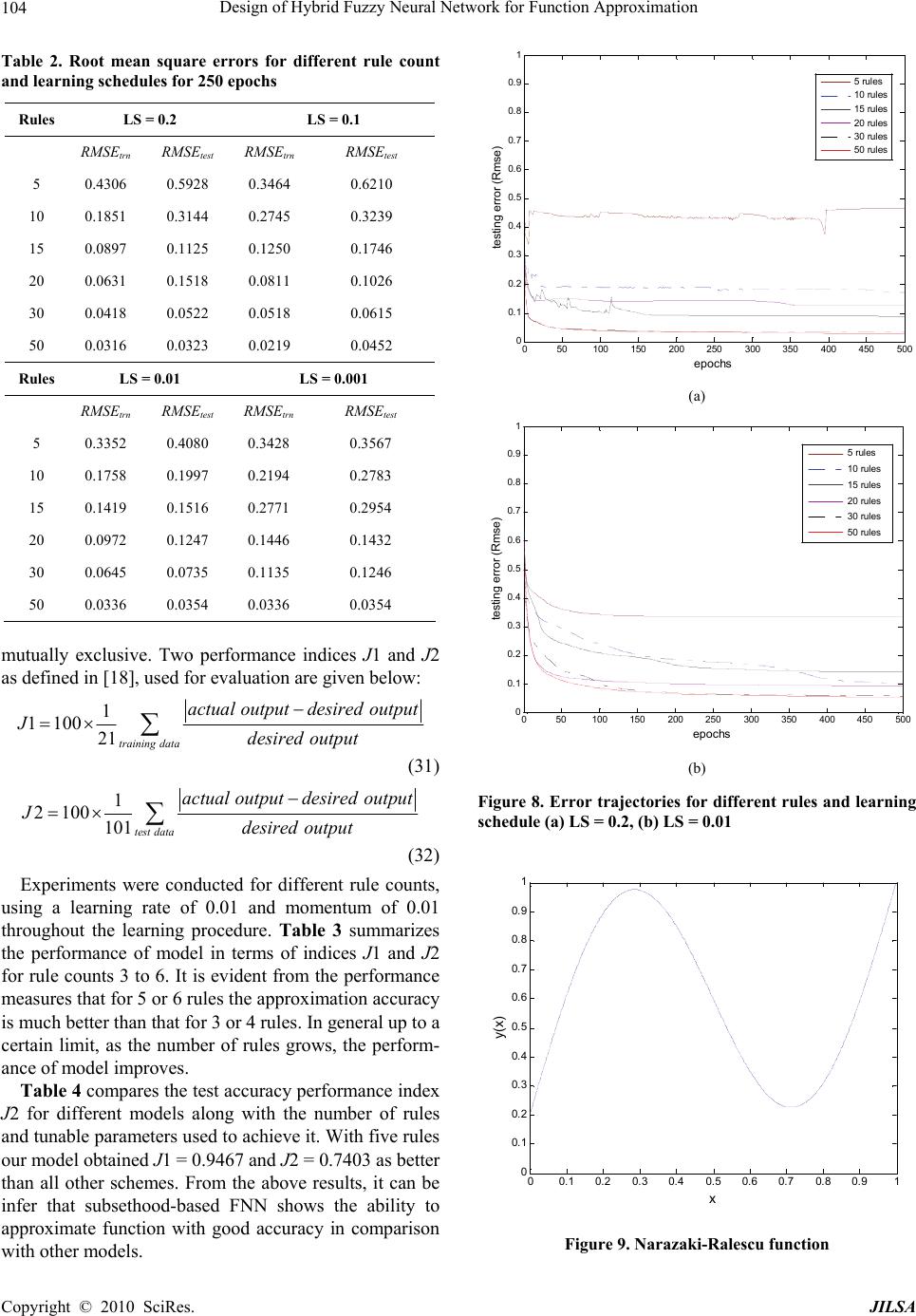 Design of Hybrid Fuzzy Neural Network for Function Approximation 104 Table 2. Root mean square errors for different rule count and learning schedules for 250 epochs Rules LS = 0.2 LS = 0.1 RMSEtrn RMSEtest RMSEtrn RMSE test 5 0.4306 0.3464 10 0.1851 0.3144 0.2745 0.3239 15 0.0897 0.1125 0.1250 0.1746 30 0.0418 0.0522 0.0518 0.0615 50 0.0316 0.0323 0.0219 0.0452 Rules LS = 0.001 5928 0.0.6210 20 0.0631 0.1518 0.0811 0.1026 LS = 0.01 RMS RMS RMSEtrn Etest Etrn RMSEtest 5 0.3352 0.3428 10 0. 15 0. 0.4080 0.3567 1758 0.1997 0.2194 0.2783 1419 0.1516 0.2771 0.2954 20 0.0972 0.1247 0.1446 0.1432 30 0.0645 0.0735 0.1135 0.1246 50 0.0336 0.0354 0.0336 0.0354 muly ee. Trforindiced J2 as dned, usvalre givw: tualxclusivwo pemance s J1 an efi in [18]ed for euation aen belo 1 110021training data Jdesired output (31) actual outputdesiredoutput 1 2100 101test data actual outputdesiredoutput Jdesired output (32) Experiments were conducted for different rule counts, using a learning rate of 0.01 and momentum of 0.01 throughout the learning procedure. Table 3 summa th rizes e performance of model in terms of indices J1 and J2 for rule counts 3 to 6. It is evident from the performance measures that for 5 or 6 rules the approximation accuracy is much better than that for 3 or 4 rules. In general up to a certain limit, as the number of rules grows, the perform- ance of model improves. Table 4 compares the test accuracy performance index J2 for different models along with the number of rules and tunable parameters used to achieve it. With five rules our model obtained J1 = 0.9467 and J2 = 0.7403 as better than all other schemes. From the above results, it can be infer that subsethood-based FNN shows the ability to approximate function with good accuracy in comparison with other models. 050 100150 200 250 300 350 400 450 50 0 0 0. 1 0. 2 0. 3 0. 4 0. 5 0. 6 0. 7 0. 8 0. 9 1 5 rules 10 rules 15 rules 20 rules 30 rules 50 rules epochs testing error (Rmse) (a) 050100 150 200 250 300350400 450 500 0 0. 1 0. 2 0. 3 0. 4 0. 5 0. 6 0. 7 0. 8 0. 9 1 epochs testing error (Rmse) 5 rules 10 rules 15 rules 20 rules 30 rules 50 rules (b) Figure 8. Error trajectories for different rules and learning schedule (a) LS = 0.2, (b) LS = 0.01 00.1 0.20.3 0.40.5 0.6 0.70.8 0.9 1 0 0.1 0.2 0.3 0.4 0.5 0.6 0.7 0.8 0.9 1 x y(x) Figure 9. Narazaki-Ralescu function Copyright © 2010 SciRes. JILSA 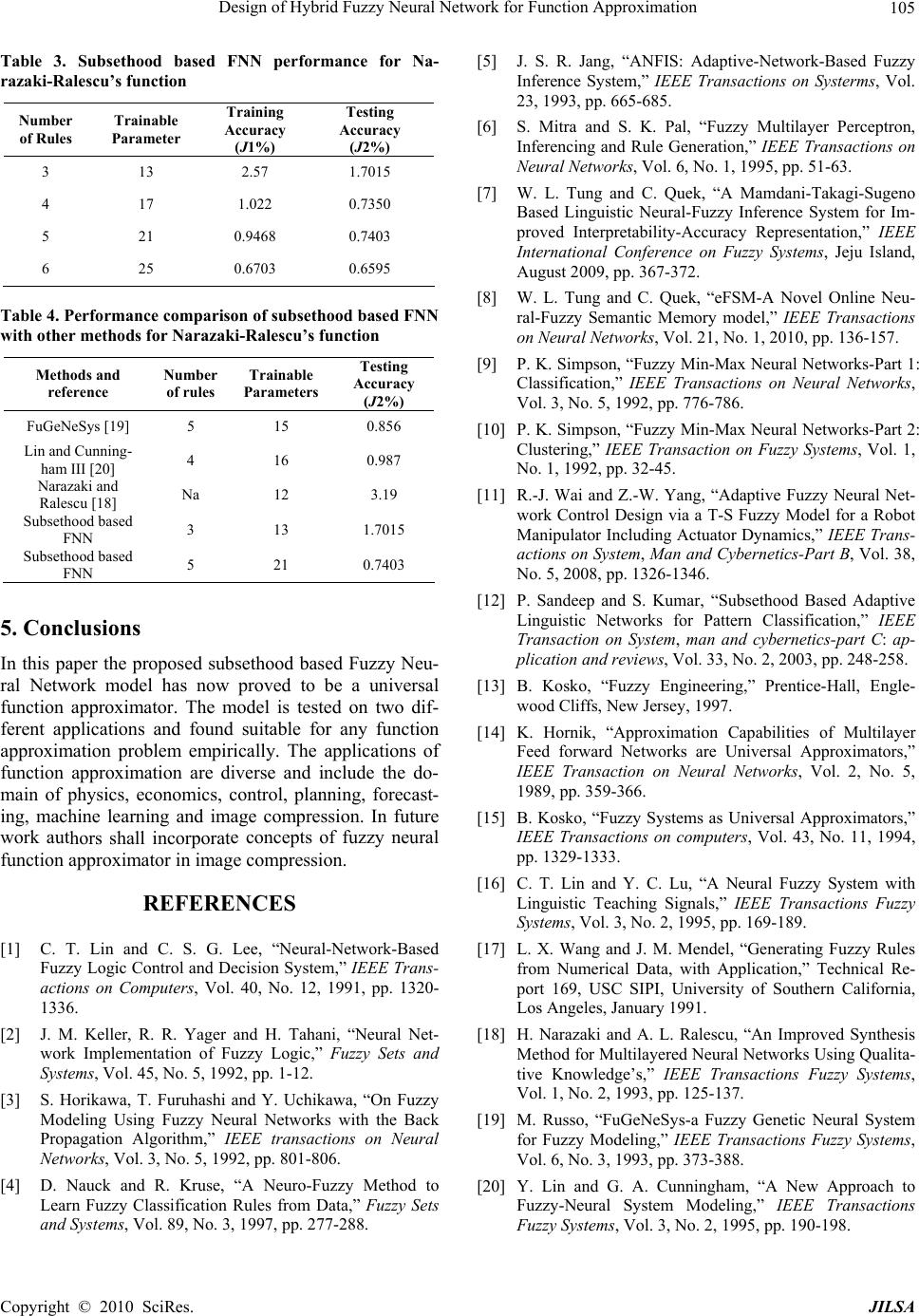 Design of Hybrid Fuzzy Neural Network for Function Approximation Copyright © 2010 SciRes. JILSA 105 Table 3. Subsethood based FNN performance for Na- razaki-Ralescu’s function Number of Rules Trainable Parameter Training Accuracy (J1%) Testing Accuracy (J2%) 3 13 2.57 1.7015 4 17 1.022 0.7350 5 21 0.9468 0.7403 6 25 0.6703 0.6595 Table 4. Performance comparison of subsethood based F with other methods for Narazaki-Ralescu’s function Methods and reference Number of rules Trainable Parameters Testing Accuracy (J2%) NN FuGeNeS0.856 ys [19] 5 15 Lin and Cunning- ham III [20] 4 16 0.987 Narazaki and Ralescu [18] Subsetho sed Na 12 od ba N Subsethood based FNN 5 1 3.19 FN 313 1.7015 20.7403 5. Cclusion In thper the osed subd basedu- al Network model has now proved to be a universal approximation problem empirically. The applications funcat ivnclo- main s, eco cnin inging a image cpression. work aute concets of fuzzy neural function approximator in image comssion. REFERENCES [1] . S. G. Lee, “Neural-Netw Fugic Controld Decisiostem,” I ns- actions on Computers, Vol. 40, No. 12, 1991, pp. 1320- . R. Yager and H. Tahani, “Neura sterms, Vol. [6] S. Mitra and layer Perceptron, Inferencing and Rule EE Transactions on Interpretability-Accuracy Representation,” IEEE vel Online Neu- al Networks, , Vol. 1, No. 1, 1992, pp. 32-45. ons is papropsethoo Fuzzy Ne r Lin function approximator. The model is tested on two dif- ferent applications and found suitable for any function of [14] K. Hornik, “Approximation Capabilities of Multilayer Feed forward Networks are Universal Approximators,” IEEE Transaction on Neural Networks, Vol. 2, No. 5, tion approximion are d nomics, erse and i ontrol, plan ude the d g, forecaof physicst- , machine learnndom p In future 1989, pp. 359-366. [15] B. Kosko, “Fuzzy Systems as Universal Approximators,” IEEE Transactions on computers, Vol. 43, No. 11, 1994, hors shall incorporat pre C. T. Lin and C zzy Lo ork-B EEE Tra ased Systems, Vol. 3, No. 2, 1995, pp. 169-189. [17] L. X. Wang and J. M. Mendel, “Generating Fuzzy Rules from Numerical Data, with Application,” Technical Re- port 169, USC SIPI, University of Southern California, Los Angeles, January 1991. ann Sy 1336. [2] J. M. Keller, Rl Net-[18] H. Narazaki and A. L. Ralescu, “An Improved Synthesis Method for Multilayered Neural Networks Using Qualita- tive Knowledge’s,” IEEE Transactions Fuzzy Systems, Vol. 1, No. 2, 1993, pp. 125-137. work Implementation of Fuzzy Logic,” Fuzzy Sets and Systems, Vol. 45, No. 5, 1992, pp. 1-12. [3] S. Horikawa, T. Furuhashi and Y. Uchikawa, “On Fuzzy Modeling Using Fuzzy Neural Networks with the Back Propagation Algorithm,” IEEE transactions on Neural Networks, Vol. 3, No. 5, 1992, pp. 801-806. [4] D. Nauck and R. Kruse, “A Neuro-Fuzzy Method to Learn Fuzzy Classification Rules from Data,” Fuzzy Sets and Systems, Vol. 89, No. 3, 1997, pp. 277-288. [5] J. S. R. Jang, “ANFIS: Adaptive-Network-Based Fuzzy Inference System,” IEEE Transactions on Sy 23, 1993, pp. 665-685. S. K. Pal, “Fuzzy Multi Generation,” IE Neural Networks, Vol. 6, No. 1, 1995, pp. 51-63. [7] W. L. Tung and C. Quek, “A Mamdani-Takagi-Sugeno Based Linguistic Neural-Fuzzy Inference System for Im- proved International Conference on Fuzzy Systems, Jeju Island, August 2009, pp. 367-372. [8] W. L. Tung and C. Quek, “eFSM-A No ral-Fuzzy Semantic Memory model,” IEEE Transactions on Neural Networks, Vol. 21, No. 1, 2010, pp. 136-157. [9] P. K. Simpson, “Fuzzy Min-Max Neural Networks-Part 1: Classification,” IEEE Transactions on Neur Vol. 3, No. 5, 1992, pp. 776-786. [10] P. K. Simpson, “Fuzzy Min-Max Neural Networks-Part 2: Clustering,” IEEE Transaction on Fuzzy Systems [11] R.-J. Wai and Z.-W. Yang, “Adaptive Fuzzy Neural Net- work Control Design via a T-S Fuzzy Model for a Robot Manipulator Including Actuator Dynamics,” IEEE Trans- actions on System, Man and Cybernetics-Part B, Vol. 38, No. 5, 2008, pp. 1326-1346. [12] P. Sandeep and S. Kumar, “Subsethood Based Adaptive guistic Networks for Pattern Classification,” IEEE Transaction on System, man and cybernetics-part C: ap- plication and reviews, Vol. 33, No. 2, 2003, pp. 248-258. [13] B. Kosko, “Fuzzy Engineering,” Prentice-Hall, Engle- wood Cliffs, New Jersey, 1997. pp. 1329-1333. [16] C. T. Lin and Y. C. Lu, “A Neural Fuzzy System with Linguistic Teaching Signals,” IEEE Transactions Fuzzy [19] M. Russo, “FuGeNeSys-a Fuzzy Genetic Neural System for Fuzzy Modeling,” IEEE Transactions Fuzzy Systems, Vol. 6, No. 3, 1993, pp. 373-388. [20] Y. Lin and G. A. Cunningham, “A New Approach to Fuzzy-Neural System Modeling,” IEEE Transactions Fuzzy Systems, Vol. 3, No. 2, 1995, pp. 190-198.  Design of Hybrid Fuzzy Neural Network for Function Approximation 106 Appendix 1. Expressions for ()Cs w iij The expression for cardinality can be evaluated in terms of the standard error function erf (x) given in (8). The ij case wise expressions for () iij Cs w for all four possi- bilities identified in Section (2.2) are as follows. Case 1—iij CC: If i , the signal fuzzy set i s d the completely belongs toweight fuzzy set , an ) the ( i Cs ij w cardinality () iij Cs w 2 (()/ ) ()() [()()] 2 ii xc iij i i Cs wCsedx erf erf . (33) , ) if j i Similarly w()( iij ij Cs wCii and () iij ij Cs w . Ifj ii , the two identical. Summarizing these three sub cases, the values of cardinality can be shown as (34). fuzzy sets are . () , ij jij iij Cs () () , () , ( ) iij ii iij iji ij iii Cs w Cs if Cw if Cw if (34) Case 2—iij CC, iij : In this case there will be exactly one cross over point h1. Assuming , the cardinality (valuated as ij i cc ) j can be e ii Cs w 22 1 1 (()/ )(()/ ) 1 1 1 2 i i i hc erf () 1 2 ij ijii hxc xc iij h ij i ij Cs wedxedx hc erf (35) If , the expression for cardinality iji cc() iij Cs w is 2 2 1 1 (()/ ) (()/ ) () ij ij ii hxc xc iij h Cs wedxedx 1 1 2 i i i hc erf 1 1 2 ij i ij hc erf (36) Case 3—iij CC , iij : In this case, there will be two crossover points h1 and h2, as calculated in (5) and (6). Assuming hh 12 and c ij i () iij Cs w c, the cardinality can be evaluated as 12 2 2 1 2 2 (()/ ) (()/ ) (()/ ) 1 2 1 () 1 2 2 2 ii ij ij ii xc ii j hxc h xc h i i i i i ij ij ij ij ij Cs wedx edx edx hc erf hc erf hc erf 1 1i hc erf h (37) if iji cc , the expression for is identical to (3 ()Cs w iij 7). Case 4—iij CC , iij : This case is similar to case 3 and once aere wil cross over points s calculated in (5) and (6 gain thl be two h1 and h2, a). Assuming 12 hh , evalu-and can be ated as x x ij i cc, the cardinality () iij Cs w 12 (()/ ) () ji ji h xc iij Cs wedx 2 2 1 (()/ ) ii hxc hed 2 2 (()/ ) ij i xc hed 1 1 2 ij ij ij hc erf 1 1 2 ij ij ij hc erf Copyright © 2010 SciRes. JILSA 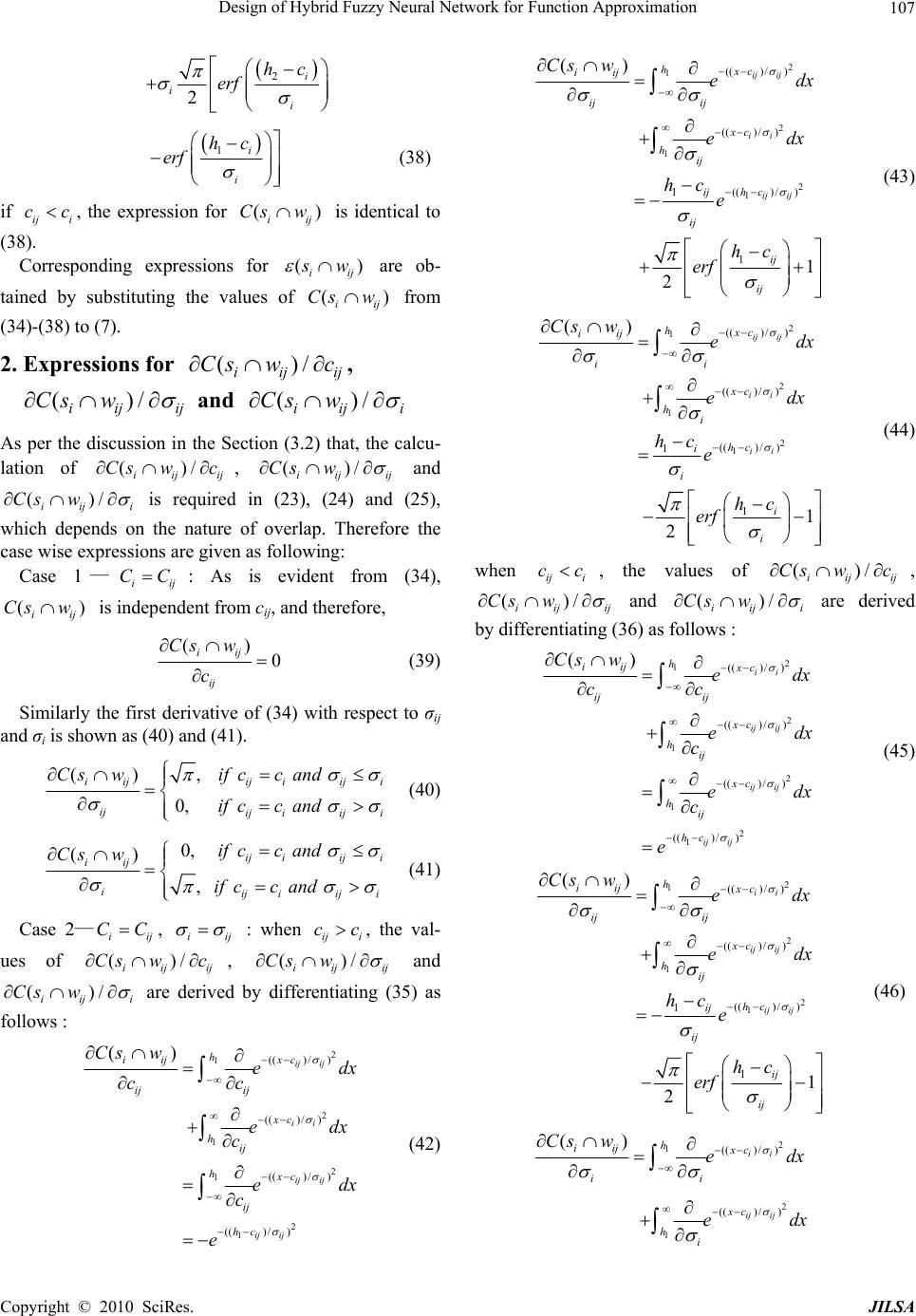 Design of Hybrid Fuzzy Neural Network for Function Approximation107 2 2 i i i hc erf 1i i hc erf (38) if , the expression for is identical to (38). Corresponding expressions for iji cc() iij Cs w () iij s w of Cs are ob- tained by substituting the values from (34)-(38) to (7). 2. Expressions for ij , () iij w ()/ iij Cs wc ij ()/ iij Cs w and () ii Csw/ j i As per the discussion in the Section (3.2) tha lation of ij , ij t, the calcu- ()/ iij Cs wc ()/ iij Cs w and ()/ i w ij i Cs is required in (225), which dends on the nature of fore the case w 3), (24) and ( peoverlap. There expressions are given as followi : As ise ng: Case 1—iij is evident from (34), () iij Cs w is independent from cij, and therefore, CC ( i Cs w (39) ) 0 ij ij c Similarly the first derivative of (34) with respect to σij and σi is shown as (40) and (41). (), 0, iij ij iiji ij ij iiji Cs wifccand if ccand (40) 0, () , ij iiji iij iij iiji if ccand Cs w if ccand (41) Case 2—jii CC, jii ()/ j ij c, : when val- ues of ij ij i cc () iij w , the ii Cs w /Cs and ()/ j iii wCs are derived by diff(3erentiating 5) as follows : 2 1 2 1 2 )/ ) 1 2 1 (()/ ) (()/ ) (( )/ ) () ij ij ii ij ij ij ij hxc iij ijij xc hij hxc ij hc Cs wedx cc edx c edx c e (42) (( 2 1(() () ij hxc iij ij ij Cs wed 2 1 2 1 / ) (()/ ) (()/ ) 11 ij ii ij ij xc h ij hc ij ij x edx er 1ij hc e 2ij hc f (43) 2 1(()/ ) () ij ij hxc iij i Cs wedx 2 1 (( )/ ) ii i xc h i ed x 2 )/ ) i 1 (( 1i hc i i i hc e 11 2 i hc erf (44) when ij i cc , the values of , ij ()/ iij Cs wc ij () iij w/Cs and () ii Csw / j i are derived by differentiating (36) as follows : 2 1 2 1 2 (( )/ ) (()/ ) ij ij ij ij xc ij xc h ed ed x 1 2 1 (()/ ) (()/ ) () ii ij ij h iij xc ijij h ij hc Cs wedx cc x c c e (45) 2 1 2 1 2 1 (()/ ) (()/ ) (()/ ) 1 1 () 1 2 ii ij ij ij ij h iij xc ij ij xc h ij hc ij ij ij ij Cs wed e hc e hc erf x dx (46) 2 1(()/ ) () ii h iij xc ii Cs wed x 2 1 (()/ ) ij ij xc hi ed x Copyright © 2010 SciRes. JILSA 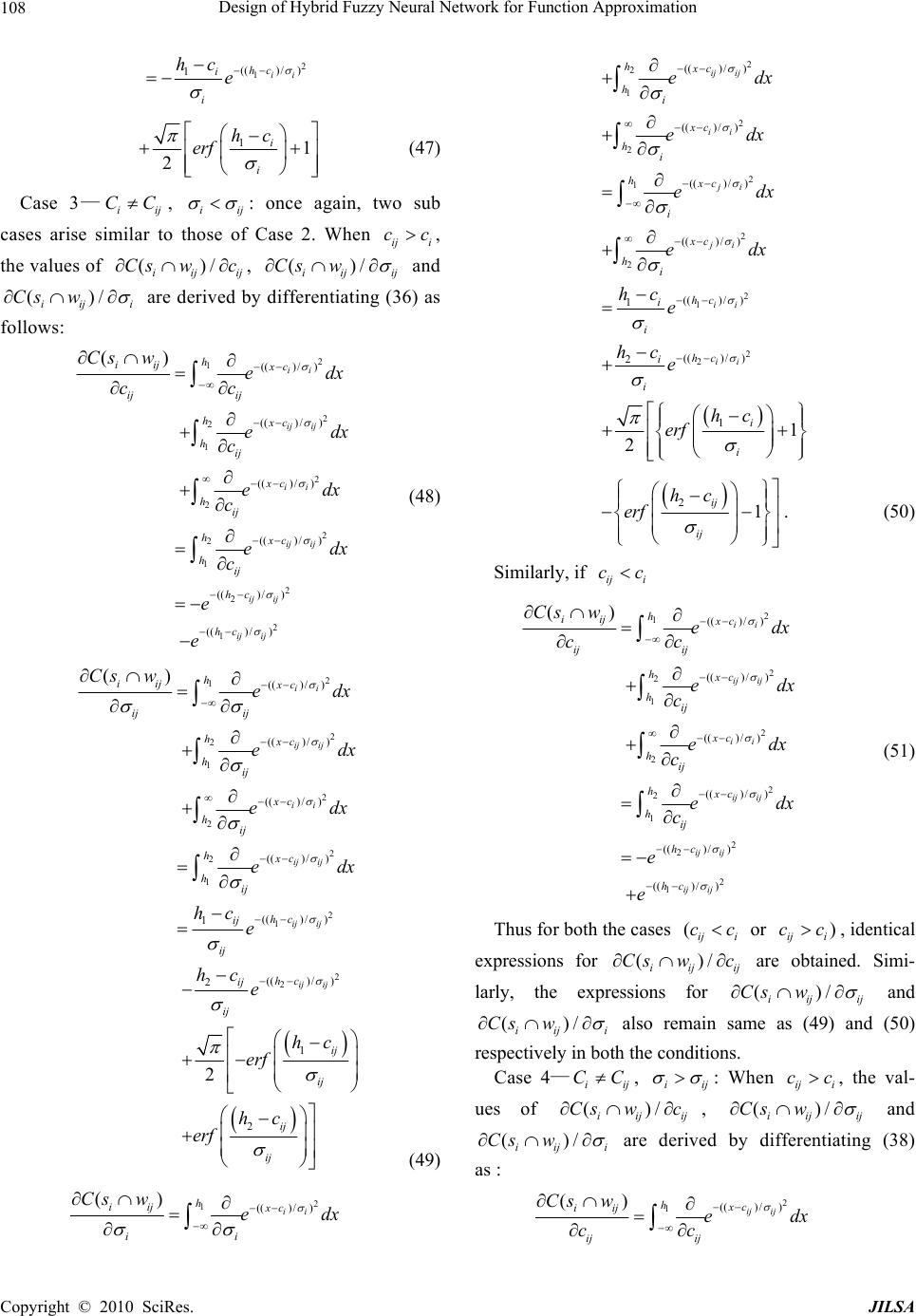 Design of Hybrid Fuzzy Neural Network for Function Approximation 108 2 1 (()/ ) 1ii hc i i hc e 11 2 i i hc erf (47) Case 3—j , jii CCii those of Ca ) / iij w c : once again, two sub cases arise se 2. When the values of i similar to (Cs iji cc, ijj , ()/ iij Cs w and () ii Csw/ j i are derived by differentiating (36) as follows: 2 1 2 2 1 2 2 2 2 1 1 (( )/ ) ij ij hij hc c e 2 2 2 (()/ ) (()/ ) (()/ ) (()/ ) (()/ ) () ii ij ij ii ij ij ij ij h iij xc ijij hxc hij xc hij hxc hc Cs wedx cc edx c edx c edx e (48) 2 1 2 2 1 2 2 2 2 1 2 1 2 2 (()/ ) (()/ ) (()/ ) (()/ ) (()/ ) 1 (()/ ) 2 1 () 2 ii ij ij ii ij ij ij ij ij ij h iij xc ij ij hxc hij xc h ij hxc hij hc ij ij hc ij ij ij ij Cs wed e x edx edx hc e hc e hc erf d x 2ij ij hc erf (49) 2 1(()/ ) () ii h iij xc ii Cs wedx 2 2 1 (()/ ) ij ij hxc hi ed x 2 2 (()/ ) ii xc hi e dx 2 1(()/) ji hxc i edx 2 (()/ ) ji xc edx 2 hi 2 1 (()/ ) 1ii hc i hc e i 2 2 (()/ ) 2ii hc i i hc e 11 2 i i hc erf 21 ij ij hc erf . Similarly, if (50) ij i cc 2 1 2 2 1 2 2 2 2 1 2 2 2 1 (()/ ) (()/ ) (()/ ) (()/ ) (()/ ) (()/ ) () ii ij ij ii ij ij ij ij ij ij h iij xc ij ij hxc hij xc hij hxc hij hc hc Cs wed cc ed c ed c ed c e e x x x x (51) Thus for both the cases , identical expressions for (ij i cc ()/ iij ij w c or ) ij i cc Cs for are Simi- larly, the exij obtained. () iij w pressions /Cs and ()/ iij Cs wi also remain same as (49) and (50) respectively in both the conditions. Case 4—ii CC j , iij ) / j ij c : When , the val- ues of ij i cc (ii Cs w , (Cs )/ iij wij and () ii w/ j i Cs are derived by diingfferentiat (38) as : 2 1(()/ ) () ij ij hxc iij ij ij Cs wed cc x Copyright © 2010 SciRes. JILSA 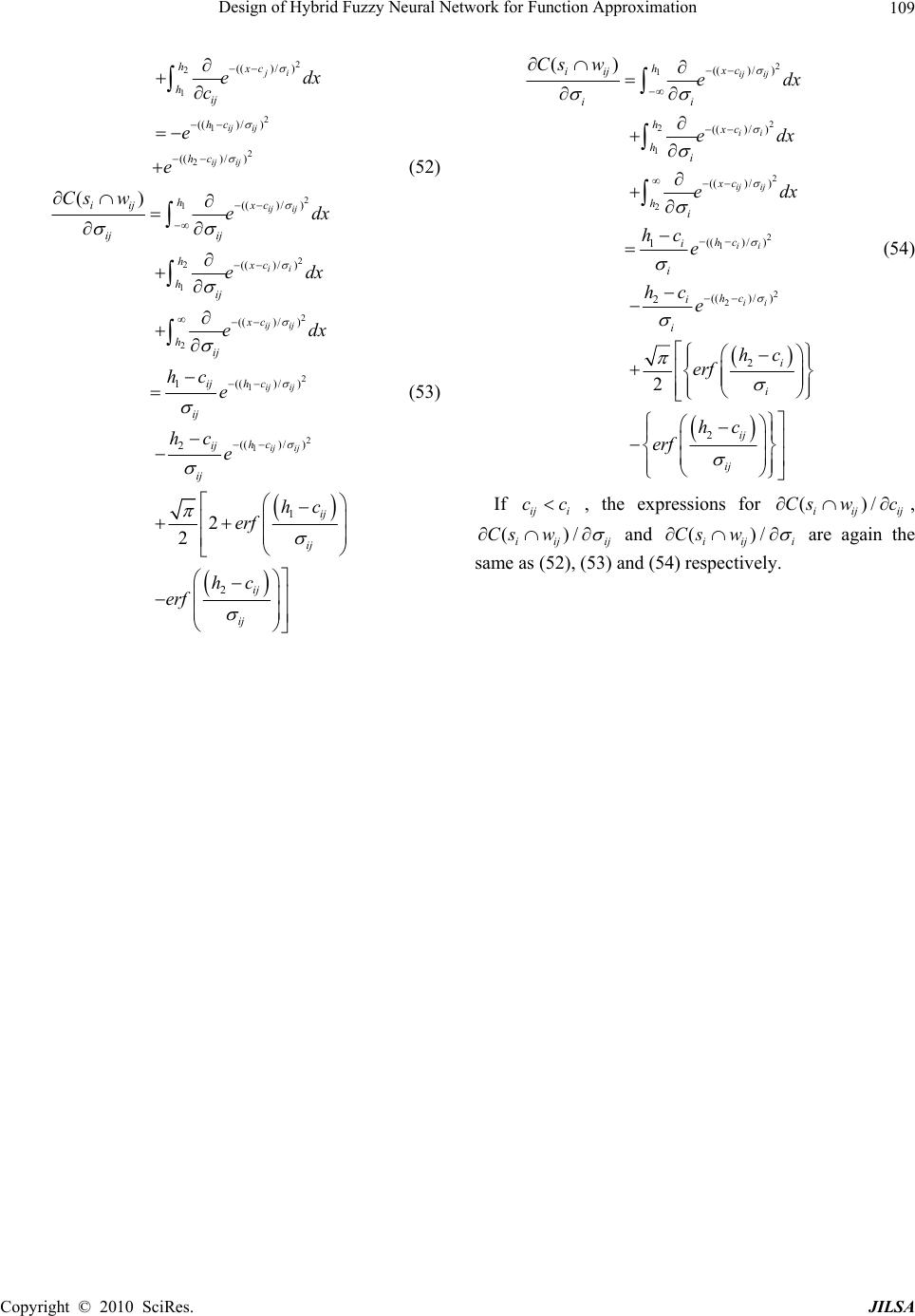 Design of Hybrid Fuzzy Neural Network for Function Approximation Copyright © 2010 SciRes. JILSA 109 2 2 1 (()/) ji hxc hij ed c 2 1 2 2 1 2 2 2 1 2 2 (()/ ) (( ) x (52) 2 1 (()/ ) ij ij hc e 2 2 (()/ ) ij ij hc e 2 ) 1 2 1 2 2 2 1 2 1 (( )/ (()/ ) (()/ ) (()/ ) 1 (()/ ) 2 1 2 () 2 2 ij ij ii ij ij ij ij ij ij hxc iij ij ij hxc hij xc hij hc ij ij hc ij ij ij ij ij Cs wedx edx edx hc e hc e h erf hc erf (53) 2 ij c / ) (()/ ) (()/ ) 1 (()/) 2 2 2 () 2 ij ij ii ij ij ii ii hxc iij ii hxc hi xc hi hc i i hc i i i i ij ij Cs wedx edx edx hc e hc e hc erf hc erf (54) If ij i cc , the expressions for ij , ij ()/ iij Cs wc () iij w/Cs and () iij Csw / i are again the same as (52), (53) and (54) respectively. |

